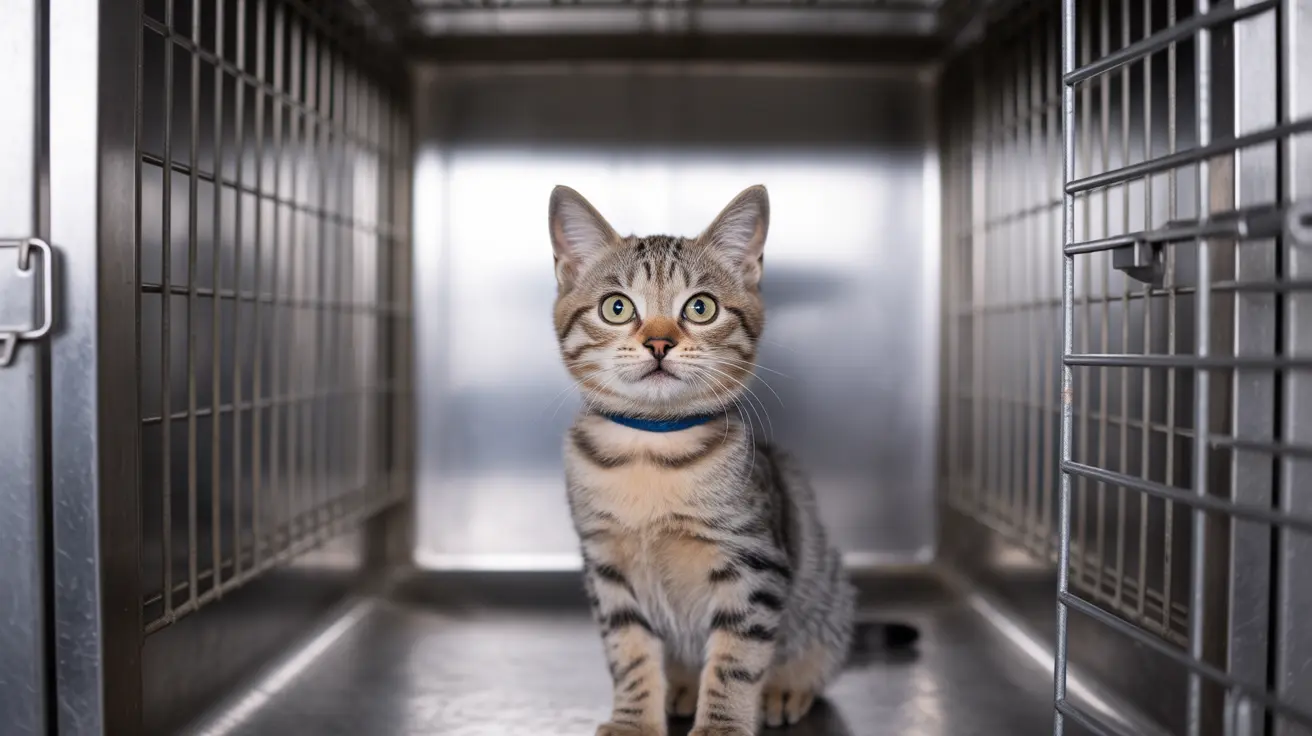The Complete Manx Cat Breed Guide: Understanding Their Unique Traits and Care Needs
The Manx cat stands out as one of the most distinctive and fascinating breeds in the feline world, captivating cat enthusiasts with their unique tailless appearance and dog-like personality. Originating from the Isle of Man, these medium-sized cats have become beloved companions worldwide, despite the complex genetic factors that create their signature look. Whether you're considering adding a Manx to your family or simply curious about this remarkable breed, understanding their characteristics, health considerations, and care requirements is essential for making informed decisions.
This comprehensive guide will explore everything you need to know about Manx cats, from the genetic mutation that defines their appearance to their affectionate temperament and specific care needs. We'll delve into the health challenges associated with their unique genetics, discuss ethical breeding considerations, and provide practical advice for creating an enriching environment for these special cats. By the end of this article, you'll have a thorough understanding of what makes Manx cats extraordinary and whether they might be the perfect addition to your home.
Understanding the Manx Cat's Unique Genetics and Physical Characteristics
The most defining feature of the Manx cat breed stems from a spontaneous dominant genetic mutation that occurred naturally on the Isle of Man. This mutation affects the brachyury gene responsible for tail development, resulting in the breed's characteristic shortened or entirely absent tail. The genetic mutation is highly penetrant, meaning it consistently expresses itself in offspring, but it comes with significant complexities that affect both breeding practices and the cats' overall health.
Tail lengths in Manx cats are classified into five distinct categories that help identify different variations within the breed. "Rumpy" cats are completely tailless, representing the most recognized form of the breed. "Rumpy risers" have a small cartilage bump where the tail would typically be, while "stumpy" cats possess a partial tail made of fused vertebrae. "Stubby" cats have short tails with non-fused bones, and "longy" cats display half to full-length tails. For show purposes, only rumpies, rumpy risers, and stumpies typically meet breed standards, though all variations are genetically authentic Manx cats.
Physical Structure and Appearance
Beyond their distinctive tails, Manx cats possess a unique body structure that sets them apart from other breeds. They are medium-sized cats with broad chests, sloping shoulders, and muscular, lean bodies that create an overall stocky appearance. Their most notable physical characteristic is their elongated hind legs, which are significantly longer than their front legs, giving them a distinctive rounded or humped appearance with a notably high rump.
The breed features rounded heads with large, round eyes that typically appear in shades of gold or copper, complemented by upright ears that add to their alert expression. Their coat can be either short or long-haired, with long-haired variants sometimes classified separately as Cymric cats. The coat texture is thick and double-layered, providing excellent insulation and a plush feel. Manx cats come in virtually all coat colors and patterns, including tabby, tortoiseshell, calico, and solid colors, though chocolate, lavender, and pointed colorations are typically not accepted in breed standards.
The Genetic Health Implications of Taillessness
While the genetic mutation that creates the Manx cat's distinctive appearance is fascinating, it also carries significant health implications that potential owners must understand. The same gene responsible for taillessness can cause a condition known as "Manx syndrome," which affects approximately 20 to 30 percent of Manx cats, particularly those with completely absent tails. This syndrome encompasses various spinal deformities, including spina bifida, which can lead to serious neurological and digestive problems.
The homozygous condition, where a kitten inherits the tailless gene from both parents, is lethal in utero and typically results in miscarriage. This genetic reality means that responsible breeders must carefully plan their breeding programs to avoid mating two entirely tailless cats together. The dominant nature of the gene ensures that when one tailless parent is bred with a tailed cat, many offspring will still exhibit the tailless characteristic while reducing the risk of severe health complications.
Common Health Challenges
Manx cats face several health challenges directly related to their genetic mutation. Megacolon, a life-threatening condition characterized by severe constipation due to nerve dysfunction, can occur in affected cats. Some Manx cats also experience incontinence, chronic constipation, and arthritis in tail stumps when present. Additionally, corneal dystrophy, an eye condition that can affect vision, has been observed in some individuals within the breed.
These health concerns underscore the importance of working with responsible breeders who understand the genetic complexities of the breed and implement careful breeding practices. The Manx Cat Genome Project, initiated in 2015, continues to research the genetics of taillessness and associated health problems, with the goal of developing breeding tests that can help maintain breed health while preserving the characteristics that make Manx cats unique.
Ethical Breeding Considerations and Global Regulations
The health challenges associated with the Manx cat's genetic mutation have sparked important discussions about ethical breeding practices and animal welfare considerations. Different countries have taken varying approaches to regulating Manx breeding, reflecting the complex balance between preserving breed characteristics and ensuring animal welfare. Germany has implemented restrictions on Manx breeding due to animal welfare concerns related to the health problems associated with the tailless gene.
Responsible breeding practices are crucial for maintaining the health and welfare of Manx cats while preserving the breed's unique characteristics. Ethical breeders avoid mating two completely tailless cats together and periodically introduce tailed cats into their breeding programs to maintain genetic diversity and reduce the incidence of severe health problems. These practices have shown success in reducing the occurrence of Manx syndrome and other genetic complications.
Prospective Manx cat owners should seek out breeders who prioritize health testing, maintain detailed health records, and are transparent about the potential health risks associated with the breed. Reputable breeders will also provide health guarantees and ongoing support to help owners understand and manage any breed-specific health concerns that may arise.
Temperament and Personality Traits of Manx Cats
Despite their unique physical characteristics and associated health considerations, Manx cats are renowned for their exceptional personalities and adaptable nature. Often described as dog-like in their behavior, these cats are notably social, tame, and active, forming strong bonds with their human families. They tend to attach particularly closely to one or two family members, though they generally remain friendly and patient with all household members, including children.
Manx cats are highly intelligent and trainable, capable of learning tricks such as fetching and even walking on a leash. Their natural hunting instincts remain strong, and they have historically been valued by farmers for rodent control and as ship's cats. This hunting prowess, combined with their loyalty and trainability, makes them excellent companions for families seeking an interactive and engaging pet.
Communication and Social Behavior
These cats communicate through a variety of vocalizations, including chirps, trills, and purrs, rather than traditional meowing. This unique communication style adds to their charm and helps them express their needs and emotions effectively to their human companions. Their social nature means they thrive on interaction and can become lonely if left alone for extended periods without adequate stimulation or companionship.
The adaptable nature of Manx cats makes them well-suited to indoor living, provided their environmental and social needs are met. They are generally calm and affectionate, making them excellent choices for families with children or other pets when properly introduced and socialized.
Practical Care Guidelines for Manx Cat Health Management
Caring for a Manx cat requires understanding their specific health vulnerabilities and implementing preventive measures to ensure their wellbeing. Regular veterinary check-ups are essential, particularly for monitoring potential spinal and digestive issues associated with Manx syndrome. Early detection and management of these conditions can significantly improve quality of life and prevent serious complications from developing.
Owners should be vigilant for signs of digestive problems, including difficulty defecating, constipation, or incontinence, as these may indicate underlying neurological issues. Maintaining a high-fiber diet and ensuring adequate hydration can help support digestive health. Additionally, providing easily accessible litter boxes and monitoring elimination habits can help identify problems early.
Grooming and Physical Care
Manx cats require regular grooming to maintain their thick, double-layered coats, with long-haired Cymric variants needing more frequent attention to prevent matting and tangling. Their unique body structure, particularly the longer hind legs, may require special consideration when it comes to mobility and joint health. Providing appropriate climbing structures and ensuring easy access to resources can help accommodate their physical characteristics.
Exercise and mental stimulation are important for maintaining both physical and psychological health in Manx cats. Their intelligent and active nature means they benefit from interactive toys, puzzle feeders, and regular play sessions that challenge their minds and keep them physically engaged.
Creating an Enriching Indoor Environment
Given that Manx cats are well-suited to indoor living, creating an enriching environment is crucial for their physical and mental wellbeing. These intelligent and active cats need plenty of stimulation to prevent boredom and behavioral issues. Interactive toys that challenge their hunting instincts, such as puzzle feeders and electronic prey-like toys, can provide essential mental stimulation while satisfying their natural predatory behaviors.
Vertical space is particularly important for Manx cats, despite their unique body structure. Cat trees, shelving systems, and climbing posts allow them to exercise their natural desire to climb and observe their territory from elevated positions. When selecting climbing structures, consider their longer hind legs and ensure that platforms and steps are appropriately spaced for comfortable movement.
Activity and Socialization Strategies
Regular interactive play sessions are essential for maintaining the physical and mental health of indoor Manx cats. Schedule multiple short play periods throughout the day using toys that mimic prey behavior, such as feather wands, laser pointers, and motorized mice. This helps satisfy their hunting instincts while providing necessary exercise and preventing obesity, which can exacerbate potential spinal issues.
Social enrichment is equally important for these naturally social cats. If you're frequently away from home, consider the companionship needs of your Manx cat. They often benefit from having another cat companion, though careful introduction processes are essential to ensure compatibility and reduce stress for all pets involved.
Multi-Cat Household Considerations and Companion Selection
Many Manx cat owners find that providing a feline companion significantly enhances their cat's quality of life, particularly if the household is often empty during work hours. When selecting a compatible second cat for a Manx, consider temperament matching rather than focusing solely on breed characteristics. Look for cats with similar energy levels and social preferences to ensure harmonious cohabitation.
The introduction process between a Manx cat and a new feline companion should be gradual and carefully managed. Start with scent swapping, allowing each cat to become familiar with the other's smell before visual contact. Use feeding time as a positive association tool by placing food bowls on opposite sides of a closed door, gradually moving them closer as the cats become comfortable with each other's presence.
Managing Multi-Cat Dynamics
Manx cats' dog-like loyalty and tendency to bond closely with specific family members can sometimes create challenges in multi-cat households. Ensure that each cat has access to their own resources, including separate feeding areas, multiple litter boxes, and individual resting spaces. This helps prevent competition and reduces stress, particularly important for Manx cats who may have mobility considerations due to their unique body structure.
Monitor interactions closely during the initial weeks of cohabitation, looking for signs of stress or conflict. The social nature of most Manx cats typically makes them good candidates for multi-cat households, but individual personality differences should always be respected and accommodated in the living arrangement.
Long-term Health Monitoring and Veterinary Care
Establishing a comprehensive healthcare routine is essential for Manx cat owners, given the breed's predisposition to certain genetic health issues. Regular veterinary examinations should include specific attention to spinal health, digestive function, and mobility assessment. Work with a veterinarian familiar with the breed's unique needs to develop a monitoring schedule that addresses potential complications before they become serious problems.
Baseline health assessments, including imaging studies of the spine when recommended, can help establish normal parameters for your individual cat and serve as comparison points for future evaluations. Keep detailed records of any health changes, particularly those related to mobility, elimination habits, or pain indicators, as these can provide valuable information for ongoing health management.
The average lifespan of Manx cats ranges from 9 to 16 years, and with proper care and health monitoring, many individuals live full, comfortable lives despite their genetic predispositions. Early intervention for health issues, combined with appropriate environmental modifications and supportive care, can significantly impact quality of life and longevity.
Frequently Asked Questions
Are Manx cats hypoallergenic?
No, Manx cats are not hypoallergenic. They produce the same allergens as other domestic cats through their saliva, dander, and sebaceous glands. Their thick, double-layered coat may actually trap more allergens than some other breeds, potentially making them less suitable for people with cat allergies.
Can Manx cats jump and climb normally despite their unique body structure?
Yes, most Manx cats can jump and climb effectively, though their longer hind legs and unique body structure may give them a slightly different movement pattern compared to other cats. Their powerful hind legs actually make many of them excellent jumpers, though individual mobility can be affected by spinal issues in some cats with Manx syndrome.
How do I know if my Manx cat is experiencing Manx syndrome symptoms?
Watch for signs including difficulty walking, incontinence, chronic constipation, difficulty defecating, or apparent pain when moving. Some cats may show a hopping gait rather than normal walking, or difficulty controlling their hind legs. Any of these symptoms warrant immediate veterinary evaluation for proper diagnosis and management.
Is it true that breeding two tailless Manx cats together is dangerous?
Yes, breeding two completely tailless (rumpy) Manx cats together typically results in lethal genetic combinations that cause miscarriage in utero. Responsible breeders avoid this practice and instead breed tailless cats with tailed cats or cats with partial tails to maintain breed characteristics while reducing genetic health risks.
Do Manx cats require special litter box considerations?
Some Manx cats, particularly those affected by neurological complications from Manx syndrome, may benefit from easily accessible litter boxes with lower sides for easier entry. Multiple boxes throughout the home can be helpful, and some cats may need larger boxes to accommodate their unique body structure and potential mobility considerations.
Are Cymric cats just long-haired Manx cats?
Yes, Cymric cats are essentially long-haired Manx cats. Some cat registries classify them as a separate breed, while others consider them a coat variant of the Manx breed. They share the same genetic mutation, health considerations, and personality traits as their short-haired counterparts, differing only in coat length and grooming requirements.
How can I find a responsible Manx cat breeder?
Look for breeders who health test their breeding cats, avoid breeding two tailless cats together, provide health guarantees, and are transparent about potential genetic health issues. Reputable breeders will allow you to visit their facilities, meet the parent cats, and provide detailed health records. They should also be knowledgeable about Manx syndrome and willing to discuss the breed's health considerations openly.
Conclusion
The Manx cat breed represents a fascinating example of how genetic mutation can create both distinctive beauty and complex health considerations. These remarkable cats offer devoted companionship, intelligence, and adaptability that makes them excellent family pets for those prepared to understand and manage their unique needs. Their calm temperament, dog-like loyalty, and social nature make them particularly well-suited to indoor living and family environments where they can form strong bonds with their human companions.
However, potential Manx cat owners must carefully consider the breed's health vulnerabilities and commit to providing appropriate veterinary care, environmental modifications, and ongoing monitoring throughout their cat's life. Working with responsible breeders, maintaining regular health assessments, and creating enriching indoor environments are essential components of successful Manx cat ownership. With proper care, understanding, and dedication, these unique cats can bring years of joy and companionship to families willing to embrace both their special needs and their exceptional personalities.






